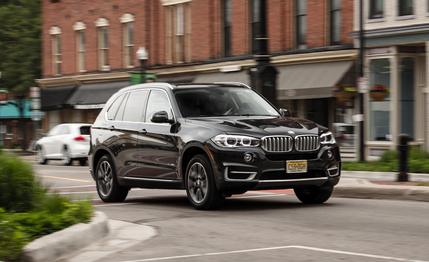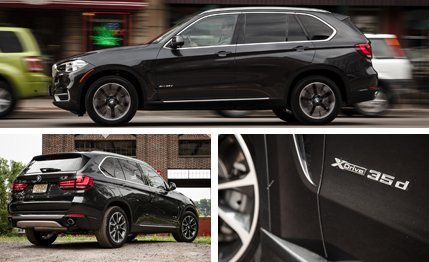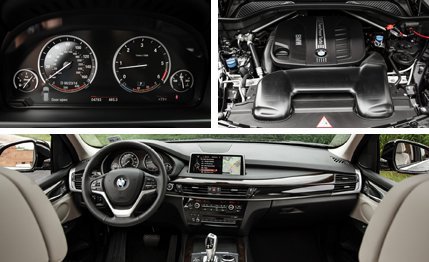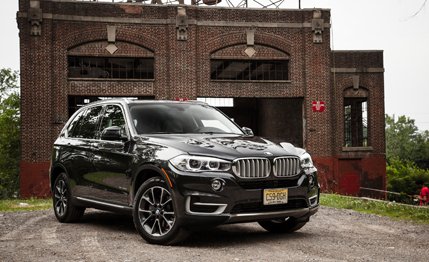 Instrumented Test
Instrumented Test
Those of us who have been consuming oxygen for more than three decades can still remember the time when SUVs were mostly working or off-road conveyances, manufactured by mid-brow brands rather than the all-purpose people movers that everyone builds today. For example, BMW’s first SUV—which the company insists is an SAV (Sports Activity Vehicle)—didn’t hit the market until the 2000 model year. BMW offers no less than five SUVs (X1, X3, X4, X5, and X6), with a larger X7 not far down the road. When the Germans find a trend they like, they blitz it.
The 2014 machine seen here was recently introduced as the third-generation version of the X5. It’s still a mid-sized, mainstream wagon—only two inches longer than its predecessor at 193.2 inches—which makes it barely longer than a Honda Accord. The planned arrival of the bigger X7 probably inhibited the normal tendency toward increasing corpulence that accompanies most model changes these days.
Although still instantly recognizable as an X5, this third-gen model looks softer and a bit more anonymous than either of its predecessors, especially when compared to the far boxier-looking first-generation X5. The newest version has a more bland profile, although its twin-kidney grille has grown more prominent and aggressive—which is the current fashion in German machines.

Inside, the new X5 provides the luxurious and comfortable cabin that has been one of the model’s hallmarks. The beltline is relatively low, which combines with the elevated driving position to afford great outward vision. The interior theme is a somewhat layered look, which is well executed and attractive, although with wood, aluminum, and red accent pieces to set off the black moldings, there are perhaps one too many elements in use.
In the middle of the dash is a freestanding LCD panel—similar to the unit in the current 3-series—which is standard equipment. The large 10.2-inch rectangular panel provides excellent resolution and is easily viewed without diverting one’s eyes too far from the windshield. The latest version of iDrive has become far easier to use than previous iterations, although it does require a few more control inputs than the more demanding, earlier versions.
As in previous versions, this X5 has a comfortable and spacious second-row seat, however the seat cushion is a little lower than we’d prefer. There’s also an optional third-row seat that is definitely for kids, since there’s not much legroom and crawling back there requires a few contortions. Cargo space is very generous with the third row folded and not bad even with those seats up. And as before, the X5 still has the two-piece tailgate that provides a nice shelf for seating or impromptu picnics.

The X5 is still available with three engines, all turbocharged. There’s a 3.0-liter six, a 4.4-liter V-8, and a 3.0-liter six-cylinder diesel, which powered our test car and probably makes the most sense for the X5. The diesel engine in the new model is a different version than BMW previously offered, losing one of the two turbochargers and ten horsepower as well as 12 lb-ft of torque. As a result, it’s slightly slower than the last X5 diesel we tested, hitting 60 mph in 7.3 seconds and covering the quarter-mile in 15.6 seconds—0.4 and 0.3 second in arrears, respectively
Offsetting the slight performance deficit is improved drive quality. The new single-turbo diesel is quieter and smoother in operation than the previous oil-burner, and a new eight-speed automatic (up from a six-speed in the last version) provides a wider ratio spread. In everyday driving, the X5 diesel feels plenty quick and responsive. But there is a bit of turbo lag when leaving from a dead stop. In situations where you have to out-drag someone else to execute a necessary lane change, you’ll find that brake torqueing to bring up the boost will be very helpful.
The X5 has never had great steering precision and this new one is only a slight improvement. It feels a little sticky on-center and lacks the fluid motion of most BMW sedans. Self-centering improves if you select Sport mode, but then the transmission is usually running one gear too low. The X5 has always been somewhat hard riding as BMW has tried to maintain responsive handling in this large and heavy package. The new version is no exception, although drivers attracted to the BMW brand will likely not object.

The diesel engine strikes us as the way to go in the X5 because it delivers plenty of usable performance while consuming little more fuel than a 3-series sedan. Its EPA estimated 26 mpg combined is easy to achieve in real-world driving (our leadfoot staff got close to that at 25 mpg). Moreover, the diesel is more attractively priced this year. At $57,525, it’s $100 cheaper than last year’s model and only $1500 more expensive than the all-wheel-drive version with the 3.0-liter gasoline six. Last year, the increment was more like $9000.
Even so, you’ll want to show some restraint when selecting options from BMW’s vast list. Our test car, with a few key options but hardly fully loaded, stickered at just $125 shy of $70K. Saving fuel while driving luxuriously still isn’t cheap.